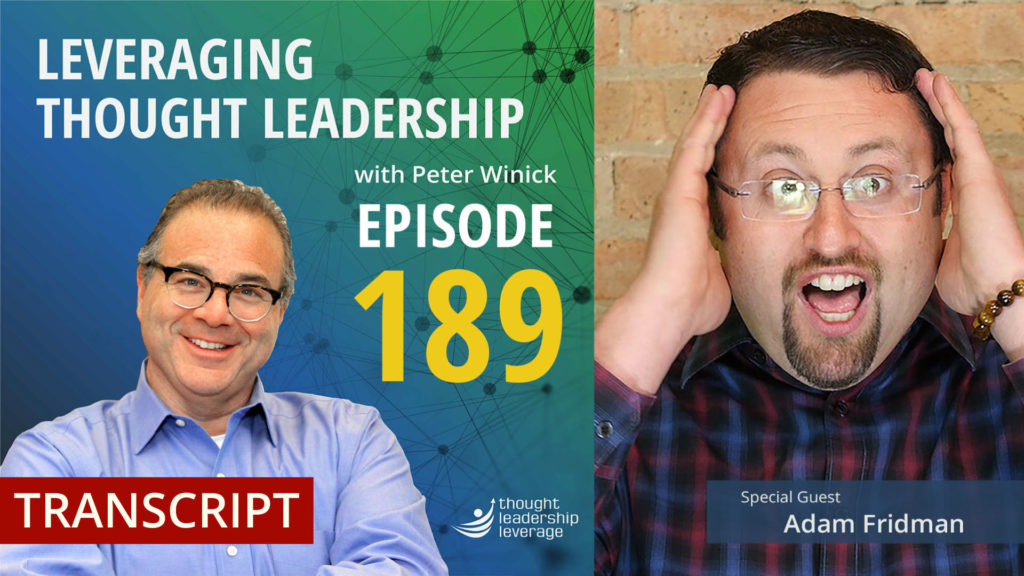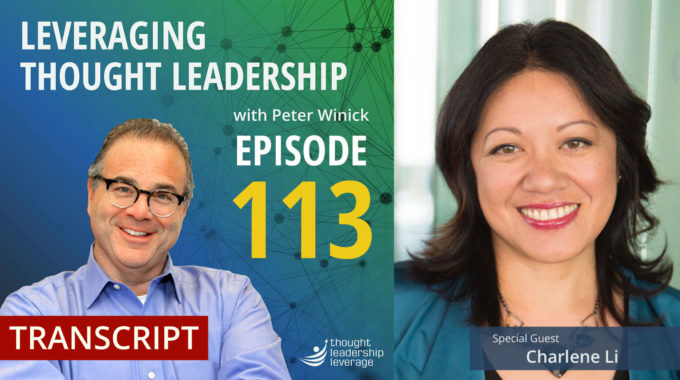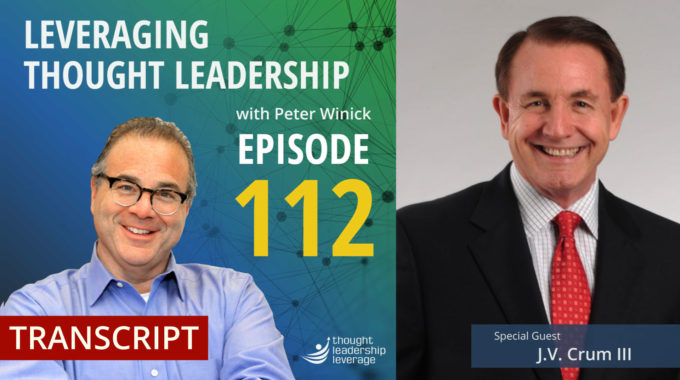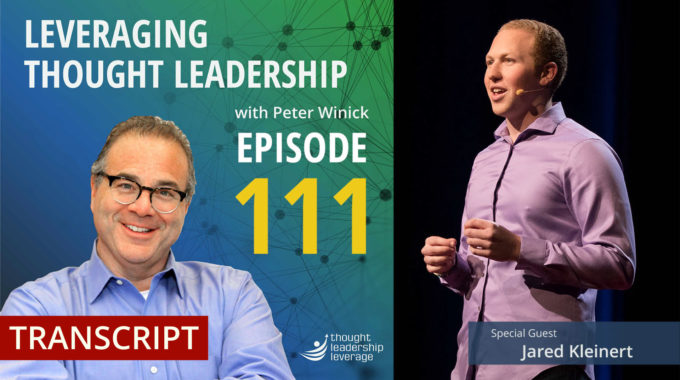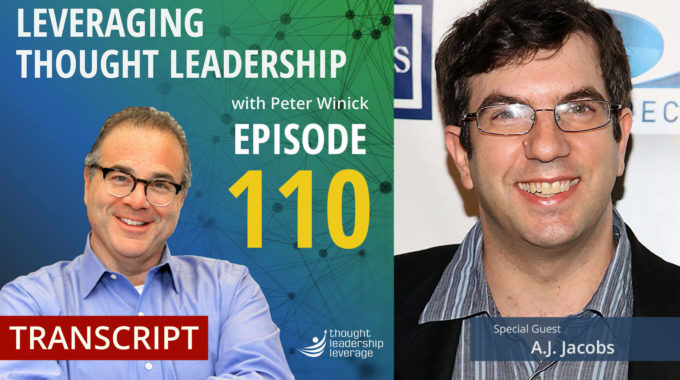Helping Your Thought Leadership Marketing Find Range, Reach, and Results. An interview with Charlene…
Build Thought Leadership in the Age of Gamification | Adam Fridman
Learning to Build Thought Leadership Using Social Media Tools, Gamification, and Multimedia
An interview with Adam Fridman about building thought leadership strategy though using the concepts of gamification that have made so many social media platforms successful.
We interviewed Adam Fridman, a seasoned entrepreneur, startup veteran, and founder of Mabbly, a Chicago-based digital marketing agency that is “Inspired by Why, Driven by Data.” As the co-author of Science of Story and creator of ProHabits, he has inspired countless organizations and individuals to make a conscious choice to pursue purpose.
Three Key Takeaways from the Interview:
- What does it mean to build thought leadership in a world dominated by social media?
- How to build thought leadership by using “gamification,” building habits that keep people coming back, and cause them to change their habits – for good.
If you’re going to build thought leadership in today’s market, you need to take into account the psychology of your audience. What makes them tick, and what gets them inspired?
Transcript:
Peter And welcome, welcome, welcome, this is Peter Winick on the founder and CEO of Thought Leadership Leverage. And you’re joining us on the podcast today, which is leveraging thought leadership. And today, my guest is Adam Fridman. He’s a seasoned entrepreneur, started veteran and a founder of the digital marketing agency Mabley, who believes that exceptional cultures happen when people pursue purpose together. He’s also the coauthor of a book called The Science of Story. And more recently, he’s the founder of a company that’s really intriguing to me called Pro Habits. And we’re gonna spend a lot of time talking about that today. So Pro Habits is a positive psychology based application that links professional habits to personal and organelle organizational development goals. In short, it it gives a much better outcome for your training development dollar than some of the traditional things that have been happening for years and years and years. Welcome aboard, Adam.
Adam Fridman Thank you. Peter, nice to – to be on.
Peter Oh, my pleasure. So, you know, you fall into sort of both buckets of folks that we have on here, which are sort of the thought leaders given that you’ve you’ve written the book on story. But we’re going to we can touch on that a little bit. But I really want to focus more today on the other side, which is which is pro habits. And in sort of full disclosure mode, you and I have been in all sorts of interesting conversations and are partnering and doing some things there. But what I find interesting about pro habits is it’s exactly what we had thought leadership leverage tell our clients at a philosophical level, which is you can’t just flood people with content and then, you know, lock them in a room for five days, pour content down their throat and then ignore them for the rest of their lives. This is really this micro dosing and gamification. So let’s take a step back and tell us what was the light bulb that went off for you that said, A-ha, I need to start a company.
Adam Fridman Thank you, Peter. You know the story and I’ll all be short. I was a contributing writer for Ink because, you know, and and that’s where the science of story the book was born for. While interviewing leaders across small to large organizations, I kept seeing this pattern. They all talked about purpose. But right after they talked about values and we’ve heard them all, if we should done some research on the Fortune 500 values, if we distill them down, there’s about five or six. So when they talked about values, I would ask them, how do you bring those values to life? And I saw smiles. I saw puzzled looks. I saw the confidence of the town hall or a workshop. But then the question of what do we do after and beyond the values that apply it across many of these abstract, really softer side of things, yet extremely important as we know. How do you make them actionable? And that was the light bulb, Peter.
Peter Got it. Because you probably had I would I would imagine a lot of smart people looking at you like like deer in the headlights.
Adam Fridman That’s that’s exactly right. I actually categorized them into two camps. The first camp would usually look at me and say, they’re on our walls, on our Web sites, we’re good.
Peter So if it’s on a coffee mug, it must be true.
Adam Fridman Exactly right. And the other the other group, that’s the one that guided me on this journey would say, Adam, you’ve talked to a lot of smart people. How do we bring these things to life? How do we have operationalize them and not having seen an answer? I knew that was my call.
Peter Wow. Very, very cool. So without getting to infomercial-ish, just give us an overview of what the sort of the underlying that is the underlying principle, but would have pro habits works with it without going too much into it.
Adam Fridman Its super super simple. But really we are what happens the day after that. As you know, Peter, once the speaker comes into the organization to inspire a movement, to inspire behavior change, we give all in the audience an easy way to enroll, to make a decision to pursue change. And then thereafter, we provide the light of such no log and experience where they commit every morning to a new micro action and an evening, they say, if they did it. And behind it, as you mentioned, there’s social proof and lots of gamification elements in order to help individuals really stay the course.
Peter And this lines up with the way people are going after behavioral change in other aspects of their life. Be that, you know, we’re getting up to dieting season or health or wellness or step tracking. I mean, this is sort of what people are doing. We’re all carrying around these devices in our pockets. We’re all tracking various things, the quality of our sleep steps, etc. So it sort of fits into that because what I’ve been observing over the last several years is the gap between the way people develop habits and learn for personal use and corporate right. Corporate is still for many for many of us have this concept of will lock them in a room for two days or a day and a half or whatever. And if someone says to you, hey, you know, hey, I’m going to start to work out more. They’re not going to lock themselves in a room for three days. They’re going to commit they’re gonna get some tools to help them. And then they’re going to, you know, get the awards and the gamification, all the thing from sort of. Gene technology merging to help us drive behavior change or those principles embedded in prohibits.
Adam Fridman Absolutely. And it’s really we often reflect on imagine a state of the health, health industry, fitness industry where you sat down, as you said, in a class. But there were no gyms. Right. There was nothing to help you bring that knowledge to life. Go ahead and fill up your milk cartons with water, as Arnold Schwarzenegger did early on, and that you can use to write, but there’s nothing else to help you. So in that same token, we think about these organizational values, we think about these big ideas that speak of bringing into organizations what happens today after. So we follow some of the principles are very similar. Peter, in tracking your progress, seeing how many days in a row. But then we also look at social media to ask the question of why is that so? Yeah. Why is the negative habits easier to build and what can we learn from them? So that’s where we take on this concept of social proof. Every time you commit, every time you say you did it, every time you saw it, share a story, everyone in your organization can see it giving you that hit of dopamine, that you’re not just doing it in isolation, you’re doing this with the social reward.
Peter And by the way, that’s the underlying secret of Facebook, Twitter, etc. It’s the calm, you know, the similar dopamine hit you get when you get a like or retweet or share or something like that. You’re taking some of the things that could have a negative implications if used to excess or for no purpose on social media. And harnessing that into positive behavior.
Adam Fridman That’s exactly right.
Peter Yeah, fascinating. So let’s talk for a little bit, because a lot of the folks listening are a variety of authors and thought leaders and speakers, and many have seen lots of different things with lots of different promises over the years. And there’s either a high level of complexity, a low level of of usage from an onboarding standpoint. It’s proprietary, it’s super duper expensive to take my content and put it into other modalities. So so that neutralize some of the fears that I sense that my author thought we were friends or sort of thinking about now a little skeptically.
Adam Fridman That’s a really great question. So let’s let’s look at it from a speaker standpoint. The first concern would be, you know, how do you make pro habits custom to me, right. To my vision of creating behavior change. And that is one of our foundations. Everything is customizable. I know, Peter, you’ve heard me say that many times. I repeated in every presentation at least four or five times. Everything is indeed customizable. Our formulas pretty simple. The micro action includes a quote, an image and then micro action for that day, as well as the quote of the author. The author is the author of the quote. That’s it. That’s the formula for our behavior change. So when we talk to the speaker, we asked the question of how do we customize for them? It’s about their behavior change. We become the delivery system.
Peter So let me play that back to you. So depending on my content, my thought leadership and my underlying philosophy of behavior change, you’re fairly flexible in terms of the integration that you think.
Adam Fridman We are the vehicle.
Peter Great. So can you give us a specific example of a piece of content that folks are probably familiar with and how that gets turned into a micro habit to develop a pro habit, if you will?
Adam Fridman Definitely. I’ll go something from, you know, probably most folks have heard of Marshall Goldsmith and I know Peter has been on your recent podcast yet, by the way, what are just an amazing gift that is given to the world through his books, his thought leadership inspired countless lives. Yeah, ever when we think about. Yeah, well, we think about his book Triggers that is asking you a series of questions to ask every day. Imagine converting those triggers into micro actions that we now send every morning, asking you to commit to asking these questions in the evening that you do it so that it would be one example. Another example that we find works really well for organizations that are looking to bring in focus or mindfulness. It’s really simple things like write down what’s most important for you to accomplish today and carry it with you all day. It’s the really simple micro actions that are really resonating with our users the most. So when we take a speaker, author and look at their fourth leadership and their book, we ask how do we take those concepts distilled down to no brainer micro actions that are easy to commit to and easy to do and don’t take more than a few minutes a day.
Peter And to me, that’s really the secret sauce, because I can tell you that if I’m like many people I know, you know, I’ve got in my office a box or a file of the takeaways or the workbooks or whatever for various programs I’ve either led or participated in and, you know, filled out a personal inventory that I got 30 percent. And then the whole thing was, oh, I know when you get back to your office. You know, continue working on this daily in isolation on top of your regular job without any sharing. And it was overwhelming. Was like it only takes to. A day who has two hours?
Adam Fridman We couldn’t agree more, Peter. And we know that what’s competing for your attention now is Instagram. So Facebook, you name the social platform that gives you the dopamine. In few seconds, as soon as you open it. How do you put that down? Open up a deep dove book for a couple hours. Pay attention. And some people do. Some people do. But that is not the majority.
Peter Yeah, yeah. And I think that’s right, because I think if you look at good, bad or evil, the behaviors that are happening in public places. So you’re standing on line at a Starbucks or an airport or something like that. What do people do? It used to be, we know, which sort of stood there. Maybe you’d make conversation with the person next to, you know, everybody’s got their phone out and some of them you aimlessly flipping through, you know, Instagram or whatever. But that’s a perfect opportunity to spend a moment or two to be reflective about a behavior that you’re trying to develop and make good use of time that is either wasted or not used in a good way or whatever the case may.
Adam Fridman And receiving a hit of dopamine while making it visible to your not just your peers, but also the executive leadership, and that’s key. Yes. You’re making a little step to improve yourself, but it is seen at the highest level of the organization and aligned to the organizational success. So, exactly, Peter, spot on. How do we replace that addiction that maybe isn’t productive for you with one that is right.
Peter So how how important. And then it’s just curiosity, quite frankly. Is it that the the sort of showing others the public piece of it, the. So the dopamine is an individual hit to me. My brain gets this hit and I feel good. So I understand that. But how important is it that others can see sort of the leader board and. Oh, look, Peter fulfilled, you know, 17 things 17 days in a row. What’s the level of importance in terms of sustaining.
Adam Fridman The social proof is critical in the way we look at social proof history. Two to two lenses. The first lens are your peers. And what’s cool about that is we have a leader board and we share all the time. Folks internally begin to talk about competition who can have more streaks, who can compete, more micro actions. And although that is important and that is where you think about comparing it to social platforms. What we think is the lifeline of behavior change is the involvement of the executives. More importantly, as we know, 70 percent of the variance in the employee experience is the manager. So that manager involvement them seeing encouraging, leading by example we feel is the single most important contributor to sticking with this type of behavior change. And because you’re doing this in the field, because you click, I commit. I did submit a story and it is seen by your manager in the context of a team that is the single most important driver of motivation.
Peter That’s something that’s unbelievable. So can you give an example if you gave the Marshall example, which I get, but where does this work really well? And then you and I have had some conversations of where this just not isn’t a tool. They don’t even consider it.
Adam Fridman Yeah, I think a great example would be Macaroni Grill, and we worked with them to help improve their reduce, I should say, their retention attrition rates and improve their retention. And what we did was to create a moment where their managers came together. They got excited. They helped to author some of the my corrections actually themselves to say, here’s the behavior of a great manager. And by bonding through that experience, by having the ownership in this type of behavior changed. We’ve seen very substantial improvements in retention within Macaroni Grill, which we know plagued the industry. That’s one example where works very well.
Peter Well, I want to push on one of the pieces that you said here that I think is important. So so. Well, actually, two pieces. One is this isn’t binary. Don’t do A only do B. You’re layering this on top of some in-person experience. Number one and number two, if I heard you correctly, that there’s an element of co-creation with the participants. We’re actually creating the habits they wanted to develop. Is that right?
Adam Fridman Yeah. This was an unusual situation where the participants themselves contributed toward the creation of the content. However, in most cases, it’s either the preview of the speaker or the author, or it’s collaboration between one of those and the organization leadership where they look at the content and they begin to infuse some of their own DNA yet to make it feel like their own. Fantastic. And the closer we get to the DNA, the more chances of a successful launch.
Peter Got it. And you said you had a successful outcome because obviously, you know, turnover, high turnover plagues the restaurant industry, hospitality industry in general. So one is you’ve you know, that people complied and actually fulfilled the mission of completing the prohibit. And then more importantly, you can you did an B and said and this control group, the data said X and we actually solved that. We solved the job you hired us to, which is to fix retention, because oftentimes I think that the disconnect from training to reality is while the participants go, that was awesome. That felt great. I gave it five stars or whatever. And then the business leader that is funding the project, both the hard cost and the soft costs. You know, look at the data. And six months later says, yeah, that’s all fine and dandy, but nothing moved.
Adam Fridman That’s exactly right. So we saw a turnover reduced on the manager levels by 60 percent year over year. Again, we were not the only initiative, but we were the initiative, a power change. And we’re still in Macaroni Grill. We’re now nine months into the engagement and then the engagement rate is at 50 percent. Nine months into the project, which is unheard of. And then we move on. We also saw turnover get reduced by the not just a manager level, but the hourly. So the impact years is translating into their own understanding, their own growth, but also the people that report into them. We’ll be publishing more in the coming months, but we’re super excited.
Peter So that’s a great example of where we’re works. And any use cases that you’d say, you know, I don’t call. This is not where we can help you.
Adam Fridman You know, we’ve had a few launches and those I’d rather not talk about the company names.
Peter Yeah. What did it? We want your very specific use cases.
Adam Fridman Conferences have a very positive outcome. If the leadership of the conference is very much engaged, if we’re being created or offered as a benefit, then we definitely see 15 to 20 percent of the folks in the audience grab on to poor habits as a way for them to manage their own growth. But 15 20 percent for us isn’t high enough. Right? Right. We’re looking for 70 percent plus and it doesn’t meet our requirements. Although my understanding and the training industry fifteen, 20 percent long term involvement is actually fairly significant. We are aiming much higher. So in the conference setting where the leadership isn’t fully involved, engaged, leading by example, we don’t see as high enrollment as we aim for.
Peter Got it. So I mean, one of things that I love that you just said there is, you know, the industry which needs to change, which is changing, which the business side of the houses is somewhat frustrated with, thinks 15 to 20 percent is good enough. And you’re saying, yeah, that’s that’s all fine and dandy, but we’re shooting for 70 and we’re getting because, you know, the funding, a program that only, you know, one out of five people consume or use, that just doesn’t make any sense.
Adam Fridman You’re right. And you know, I didn’t grow up in the industry. I’m learning to understand what the industry is like. But for me, it’s about getting something so easy to use that rivals the other experiences in the digital age. And if you can accomplish that. The only question becomes, are people engaged with the organization? Correct. If they are engaged, they will then by virtue of that, begin an experience that’s flawless for them. And if they’re not engaged and you have much greater problems.
Peter Right. And then at the root of what you said, there is this easy to use, because I think we know over the last 10, 15 years, whatever the case may be. So many things have become so much easier. I mean, everything from it used to be when you bought a printer for your home office, it was like, oh, god, the settings. Is that everything? You turn it on. You know that installing a nest thermostat. Now you’ve got a nest in the app goes on it like, well, our magic, you know what it’s like. Those are the, you know, taking a iPhone out of the box. That little noise it makes, you know, like these are the experiences that the end user, the consumer has been taught is what you should expect. And then they move into the workplace in training, development of learning. And it’s like, oh, let’s go back to the stone ages. And I think that’s not that’s not going to continue to be the way it is.
